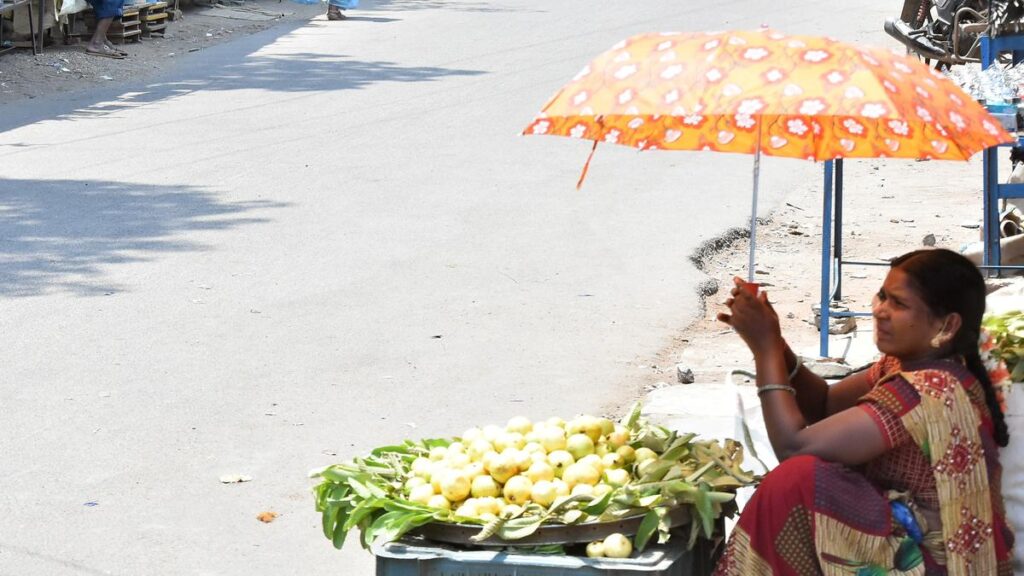
A fruit seller shades herself with an umbrella in intense heat at Sangareddy, Telangana.
| Photo Credit: Mohd Arif
On May 12, 17 districts of Andhra Pradesh recorded temperature above 41º C, with the A.P. State Disaster Management Authority (APSDMA) saying heatwave-like conditions are set to prevail in the northern districts of Srikakulam, Vizianagaram, Paravathipuram-Manyam and East Godavari, and Kakinada.
Mercury levels surged past the 40º C mark across all 33 districts of Telangana on April 21. Adilabad was the hottest with a maximum temperature of 44º C, according to data from the Telangana Development Planning Society.
Situated on the eastern side of the Deccan plateau in South India, Andhra Pradesh and Telangana feature regularly on the list of Indian States most prone to heatwaves during the summer.
Both Andhra Pradesh and Telangana experience very hot summers due to a mix of geographical and climatic reasons.
First up: the geographical location of the States.
Latitudinally, both Andhra Pradesh and Telangana fall under the Tropic of Cancer. This puts the States in the Torrid (or tropical) Zone – a region characterised by its hot and humid weather. “Both AP and Telangana are near the Tropic of Cancer, therefore the sun is vertically above these States during summer months, leading to increased solar radiation and heating,” Mahesh Palawat, Vice president Meteorology and climate Change at Skymet, told The Hindu.
Telangana experiences an additional layer of continental climate too. Telangana is a landlocked State, with no major water bodies nearby to moderate temperatures. As a result, it experiences a continental climate, where temperatures can rise sharply during the day. This is also true for interior districts of Andhra Pradesh, which are far from the sea.
According to Mr. Palawat, most parts of Telangana lie on the rocky terrain of the Deccan plateau with black soil, which absorbs more heat, causing temperatures to spike.
“Land surface, terrain and green cover make a lot of difference to the temperature of an area,” Vimal Mishra, professor at IIT Gandhinagar, told The Hindu. “If you compare these States to regions which are under intensive agriculture or have dense forests, those areas are much cooler due to evaporative cooling,” he said.
Evaporative cooling is a process that leads to a reduction in temperature of the surroundings as water evaporates. Water requires energy to convert from liquid to gaseous state. In drier climates, when water evaporates, it takes up heat from the surroundings as its source of energy to convert to vapour, thus cooling the surroundings. “The terrain of Telangana and Andhra Pradesh is rocky and there isn’t much agriculture during summer at least, and effect of irrigation is minimal,” Dr. Mishra said. He also said that there is ample research to show that irrigation makes a lot of difference to summer air temperatures, and it can reduce dry bulb temperatures and suppress heatwaves. This phenomenon is very well pronounced in areas like the Indo-Gangetic plains, he added. “Irrigation involves using water on land surface, which is stored as soil moisture. During high temperatures in summer, evaporation from soil and transpiration from plants causes evaporative cooling in the area, reducing the intensity of heatwaves,” Dr. Mishra said. The rocky terrain of Andhra Pradesh and Telangana does not allow for this phenomenon to be pronounced enough for it to make a difference in temperatures.
Lack of sufficient rainfall is another factor that leads to high summer temperatures in Andhra Pradesh and Telangana. “Between March and May, these States don’t get enough rainfall to cool down the temperatures. Monsoon reaches here after June 10. This causes less cloud cover and more sunshine, hence leading to higher temperatures,” Mr. Palawat said.
Loss of forest cover also leads to reduction in evapotranspiration, leading to increase in localised temperatures. According to the State of Forest Report 2023, Andhra Pradesh lost 138.66 sq km of forest cover compared to the 2021 assessment, while Telangana lost 100.42 sq km.
Challenges and mitigation
According to Dr. Mishra, the absence of early warnings forecast system based on hourly observations is one of the biggest challenges to mitigating heatwaves. “The India Meteorological Department has started working in this area, but lot of progress is still to be made.”
Understanding the risk is the first step towards mitigating impact of heat waves, which should be followed by differentiating districts based on dry heat and humid heat, Dr. Mishra said. “Early warning systems have proven to be very effective for heatwaves, but they remain ineffective because we don’t understand the differential risk – heat challenges require different solutions based on the local nature of impacts,” he said.
Published – May 14, 2025 06:00 pm IST

